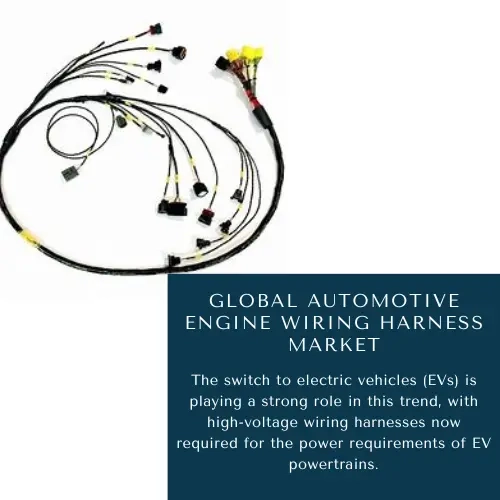
- Get in Touch with Us

Last Updated: Apr 25, 2025 | Study Period: 2024-2030
The global automotive engine wiring harness market is an important part of vehicle electrical systems that connect different components of the car to enable power and information based on signals. An engine wiring harness is a bundle of wires, connectors, and protective sleeves that isolate the bundles of wires to keep heat moisture, and dust dirt out.
Growing automotive engine wiring harness demand is primarily attributed to the increasing complexity of vehicle electrical architectures due to technological advancements in engine management systems, infotainment technologies, and safety features. In harness designs, the use of quality materials such as copper conductors and heat-resistant insulations enhance electrical performance while providing minimized EMI protection in harsh operating conditions.

Advances in the technology of automotive wiring harness manufacturing have led to the utilization of automation-aided assembly, as well as modular designs resulting in lowered production costs and lead times with enhanced manufacturability at scale. Wiring harness enables the integration of sensor arrays, electronic control units (ECUs), and advanced driver-assistance systems (ADAS) for enhanced vehicle performance, safety features as well as connectivity aids.
Engine wiring harnesses are changing with the growing focus on automotive OEM light-weighting efforts and vehicle electrification trends. In addition, new materials innovations applied in products are looking to improve sustainability and lower environmental footprints over the full product life cycle with recyclable polymers or bio based ones.
In terms of market growth on the horizon, high-tech solutions are making way for significant potential in automotive engine wiring harness products that now feature a host of innovative technology, regulatory-compliant demands, and new EV monitoring platforms. With automotive manufacturers transitioning to next-generation vehicle architectures and connectivity solutions, engine wiring harnesses will remain a key enabler for cost-effective & reliable yet future-proof electric systems of vehicles.
The engine wiring harness in an automobile is the cluster of wires that carry electrical power and signals to various parts of different systems, such as controllers or sensors. The harness, including the bundles of wires and connectors they use to connect backers ensures thorough electrical conductivity while protecting them from environmental influences such as heat or moisture. The key component is essential as it greatly contributes to the smooth integration and operation of engine systems in multiple vehicle platforms.
Designed to stringent performance and durability standards, engine wiring harnesses also allow for features such as complex electrical configurations that are compatible with on-board vehicle health diagnostics unit and telemetry information, and advanced automotive controls. The design of the harness takes into account parameters such as wire gauge, insulation material, and connector type to ensure high electrical conductivity, low susceptibility to electromagnetic interference (EMI) and eliminate failures in harsh operating conditions.
Among the technological advancements in automotive wiring harnesses are hybrid and compact materials which may aid manpower reduction while minimizing cost; lightweight to enhance fuel efficiency, flexibility/adaptability features required by different car models, ease of repair if rolled into an accident limited environmental impact improvements-both visible immediately due some advances such electric drive system support fashionable.. -while particle size does a better supporting specific function fit allows easier affixments desired parts;. Additionally, harnesses are advancing to enable sensor arrays and electronic control units (ECUs) integration for more advanced diagnostics as well as adaptive controls to improve vehicle performance and safety.
The function of the engine wiring harnesses is very critical as automotive electrification trends gather steam, with electric motors and battery management systems becoming ubiquitous in addition to ADAS (Advanced Driver Assistance Systems) adoption. Similarly, future harness designs will focus on scalability and flexibility for emerging powertrain technologies that tune vehicles out of our time in both better efficiency but also enhanced connectivity with charging infrastructures to advance eMobility in an environmentally friendly direction.

The Global Automotive Engine Wiring Harness Market was valued at $XX Billion in 2023 and is projected to reach $XX Billion by 2030, reflecting a compound annual growth rate (CAGR) of XX% from 2024 to 2030.
High-Voltage Wiring for Electric Vehicles: The transition to electric vehicles (EVs) has led to the development of high-voltage wiring harnesses that can cope with growing power requirements from EV drivelines These harnesses are created to provide safety and performance in high-voltage environments.
Lightweight Materials and Designs: The deployment of lightweight materials, such as aluminum and advanced polymers in wiring harnesses is reducing vehicle weight to improve fuel economy. To meet ever more severe fuel economy and emissions regulations, lightweight designs are essential.
Smart Technologies integration: Smart wiring harnesses built with sensors and communication capabilities are making it possible to monitor electrical systems in real time. These harnesses enable advanced vehicle features and predictive maintenance.
Modular Wiring Harness Systems: Increasingly popular, modular wiring harness systems that aided in easier customization and scalability. This flexibility allows the systems to adapt to numerous vehicle layouts and models, as it streamlines installation online with lower production complexity.
Yazaki Corporation - High-Voltage Wiring Harnesses: Yazaki launched a new high-volt wiring harness intended for electric and hybrid vehicles. To cater to the power demands of today's modern EV powertrains, with higher voltage routing and needs for optimized thermal management this harness will do the job perfectly.
Sumitomo Electric Industries - FLEX Connectors: Electric Industries - FLEX Connectors launched by Sumitomo for automotive engine wiring harnesses, providing increased flexibility and durability in the harsh environment of the engine. Connectors that improve installation productivity and reliability.
Delphi Technologies - Intelligent Wiring Systems: Delphi Technologies advanced the world's first smart wiring systems that incorporate sensors and information correspondence highlights, permitting ongoing checking and diagnostics of motor parts.
Leoni AG - Aluminum Wiring Harnesses: To help cut vehicle weight and improve fuel economy, Leoni AG revealed a line of lighter-weight aluminum wiring harnesses that is up to 30 percent (by mass) slimmer than current systems. They are specially designed to cope with the increasing temperatures and vibrations found in engine compartments.
| Sr.N | Topic |
| 1 | Market Segmentation |
| 2 | Scope of the report |
| 3 | Research Methodology |
| 4 | Executive Summary |
| 5 | Average B2B by price |
| 6 | Introduction |
| 7 | Insights from Industry stakeholders |
| 8 | Key Drivers for Global Automotive Engine Wiring Harness market |
| 9 | Disruptive Innovation in the Industry |
| 10 | Overview of Global Automotive Engine Wiring Harness Market |
| 11 | Major impact on Technological advancements |
| 12 | Consumer trends in the industry |
| 13 | Recent technological trends in Global Automotive Engine Wiring Harness Market |
| 14 | SWOT Analysis of Key Market Players |
| 15 | New product development in the past 12 months |
| 16 | Market Size, Dynamics, and Forecast by Geography , 2024-2030 |
| 17 | Market Size, Dynamics, and Forecast byVehicle Type , 2024-2030 |
| 18 | Market Size, Dynamics, and Forecast by Component Type , 2024-2030 |
| 19 | Market Size, Dynamics, and Forecast by Application , 2024-2030 |
| 20 | Competitive landscape |
| 21 | Gross margin and average profitability of suppliers |
| 22 | Merger and Acquisition in the past 12 months |
| 23 | Growth strategy of leading players |
| 24 | Market share of vendors, 2023 |
| 25 | Market Company Profiles |
| 26 | Unmet needs and opportunities for new suppliers |
| 27 | Conclusion |